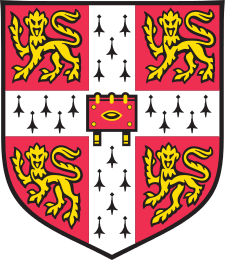Churchill College, Cambridge
| Colleges of the University of Cambridge | ||||||||||||||||
| Churchill College | ||||||||||||||||
 | ||||||||||||||||
|
| ||||||||||||||||
| Named after | Sir Winston Churchill | |||||||||||||||
| Established | 1958 | |||||||||||||||
| Master | Dame Athene Donald | |||||||||||||||
| Undergraduates | 450 | |||||||||||||||
| Graduates | 280 | |||||||||||||||
| Sister college | Trinity College, Oxford | |||||||||||||||
| Location | Storey's Way (map) | |||||||||||||||
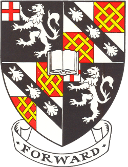 | ||||||||||||||||
| "Forward" | ||||||||||||||||
| College website | ||||||||||||||||
| JCR website | ||||||||||||||||
| MCR website | ||||||||||||||||
| Boat Club website | ||||||||||||||||

Churchill College is a constituent college of the University of Cambridge, England. It has a primary focus on science, engineering and technology, but still retains a strong interest in the arts and humanities.
In 1958, a trust was established with Sir Winston Churchill as its chairman of trustees, to build and endow a college for 60 fellows and 540 students as a national and Commonwealth memorial to Winston Churchill; its Royal Charter and Statutes were approved by the Queen, in August 1960.[1] It is situated on the outskirts of Cambridge, away from the traditional centre of the city, but close to the University's main new development zone (which now houses the Centre for Mathematical Sciences). Its 160,000 m² (42 acres) of grounds make it physically the largest of all the colleges.
Churchill was the first all-male college to decide to admit women, and was among three men's colleges to admit its first women students in 1972.[2] Within 15 years all others had followed suit. The college has a reputation for relative informality compared with other Cambridge colleges, and traditionally admits a larger proportion of its undergraduates from state schools.
The college motto is "Forward". It was taken from the final phrase of Winston Churchill's first speech to the House of Commons as Prime Minister—his famous "Blood, Toil, Tears and Sweat" speech - in which he said "Come, then, let us go forward together".[3]
History
In 1955, on holiday in Sicily soon after his resignation as Prime Minister, Winston Churchill discussed with Sir John Colville and Lord Cherwell the possibility of founding a new institution. Churchill had been impressed by MIT and wanted a British version, but the plans evolved into the more modest proposal of creating a science and technology based college within the University of Cambridge.[4] Churchill wanted a mix of non-scientists to ensure a well rounded education and environment for scholars and fellows. The college therefore admits students to read all subjects except Land Economy and Theology & Religious Studies (though it is possible to switch to these subjects later).
The first postgraduate students arrived in October 1960, and the first undergraduates a year later. Full College status was received in 1966. Initially all students were male. Women were not accepted as undergraduates until 1972.
The bias to science and engineering remains as policy to the current day, with the statutes requiring approximately 70% science and technology students amongst its student intake each year.[5] The college statutes also stipulate that one third of the students of the college should be studying for postgraduate qualification.
Cambridge University Radio (later Cam FM) broadcast from Churchill College from 1979 until 2011.
Buildings and grounds
In 1958, a 42-acre (170,000 m²) site was purchased to the west of the city centre, which had previously been farmland. After a competition, Richard Sheppard was appointed to design the new college. Building was completed by 1968 with nine main residential courts, separate graduate flats and a central building consisting of the dining hall, buttery, combination rooms and offices.
The dining hall is the largest in Cambridge. It measures 22m square, 9m to the base of the vault beams, and 11.6m to the highest point. It can cater for up to 430 guests in a formal dining arrangement.
The main college buildings and courtyards are arranged around a large central space, in which the library was placed. Only a few years later, being opened in 1974, an extension to the library building was added to house the Churchill Archives Centre. Its original purpose was to provide a home to Sir Winston's papers, however since then it has been endowed with papers from other political figures including former Prime Ministers Margaret Thatcher and John Major, as well as former Leader of the Opposition Neil Kinnock, and those of eminent scientists and engineers including Reginald Victor Jones, Rosalind Franklin and Sir Frank Whittle.[6]

In 1992, the Møller Centre for Continuing Education was built on the Churchill site, designed by Henning Larsen. It is a dedicated residential executive training and conference centre, aiming to bring together education and commerce.[7]
As well as the main College buildings, Sheppard designed a separate group of flats, known as the Sheppard flats, for the use of married graduate students. These are located to one side of the College grounds, a short distance from the main buildings.
Chapel
At the farthest end of the college grounds is the Chapel. Sheppard's original design placed it within the main building complex near the college main entrance.[8] The idea of having a religious building within a modern, scientifically-oriented academic institution deeply annoyed some of the original fellows, leading to the resignation of Nobel Prize winner Francis Crick in protest.[9] Eventually a compromise was found: the chapel was sited just to the west of the Sheppard Flats,[10] and funded and managed separately from the rest of the College itself, being tactfully referred to as "the Chapel at Churchill College". The chimney of the heating system at the front of the college substitutes visually for the missing chapel tower.
Crick had agreed to become a fellow on the basis that no chapel be placed at Churchill. A donation was later made by Lord Beaumont of Whitley to Churchill College for the establishment of one, and the majority of fellows voted in favour of it. Sir Winston Churchill wrote to him saying that no-one need enter the chapel unless they wished to do so, and therefore it did not need to be a problem. Crick, in short order, replied with a letter dated 12 October 1961 accompanied by a cheque for 10 guineas saying that, if that were the case, the enclosed money should be used for the establishment of a brothel. This story was repeated by Crick in an interview with Matt Ridley (Crick's biographer[11]), quotes from which are reported in the Daily Telegraph.[12]
Artworks and sculptures


The college contains many examples of modern artwork including:
- Four square walk-through – Dame Barbara Hepworth
- Prints of Marilyn Monroe – Andy Warhol
- Gemini (1973) – Denis Mitchell
- Diagram of an Object (Second state) (1990)[13] – Dhruva Mistry
- Spiral – Michael Gillespie (1993)[14]
- Flight – Peter Lanyon (1981)
- Black Bag – Graham Murdoch (1990)
There are also works by Sir Eduardo Paolozzi, Bridget Riley, Patrick Caulfield, Sir Peter Blake, and Daphne Hardy Henrion.
Mistry's piece can be found at the front of college. Sir Anthony Caro's Forum[15] used to stand near it but it was removed before the start of the 2004-2005 academic year. In January 2007 its place was taken by Beast Alerted 1, a sculpture by British sculptor Lynn Chadwick.
Student life
The student population is divided into two common rooms: the Junior Common Room (JCR) and Middle Common Room (MCR). The former contains undergraduates and the latter advanced students. Fourth year undergraduates studying towards their Masters may choose to be in either.[16] These student bodies organise various academic and social events as well as handling issues regarding welfare. The college funds sports clubs and societies which provide entertainment for students.
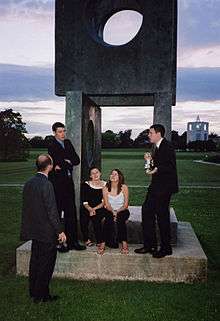
Social events
Every two weeks of the Michaelmas and Lent terms, and twice in Easter term, Churchill is host to Pav, a music event unusual for Cambridge events in that it is free and open to all university members. The name Pav originates from the pavilion buildings of the college where the event was originally held. Since 1992, Pav has been held in the Buttery, the main bar area.
In the early years of the college's foundation, the college held a ball in May Week, in common with many older colleges. However, more recently Churchill has held a Spring Ball every February, close to Valentine's Day. The Ball has hosted a number of upcoming bands, such as The Wombats (2007) and The Noisettes (2008).
During May Week the JCR organise a free garden party. The event hosts performances from local bands and musicians.
Students of the College run Churchill Casino,[17] a Cambridge-based enterprise which provides professional casinos at various social events. Churchill Casino is frequently hired for Cambridge May Balls as well as balls at the University of Oxford and corporate events throughout the country. Profits have been donated back towards the college and to local charities.[18]
The MCR has its own reserved area, the Sandy Ashmore Room, where students may socialise. This incorporates a student-run bar known as the Vicious Penguin.[19] The MCR organises a range of activities including an annual conference, the Conference on Everything and hosts termly Guest Nights.[20] The Conference on Everything gives students an opportunity to present their own research as well as featuring talks from distinguished speakers including Salah Al-Shaikhly, the Iraqi ambassador to the United Kingdom; Michael Green, Lucasian Professor and pioneer of string theory; Julian Huppert, scientist and MP for Cambridge; David Spiegelhalter, Winton Professor of the Public Understanding of Risk, and Nicholas Bingham, Senior Investigator at Imperial College London and Visiting Professor of Mathematics at the London School of Economics.[21]
Sport
With playing fields on site, unlike many other colleges, sport is an integral part of the college. As well as football pitches, a cricket pitch and others, the facilities include a gym, and tennis and squash courts.
Churchill College Football Club (CCFC) were the first college team to retain the Cambridge University Amateur Football League Division 1 title, winning it in 2005–06 and 2006–07. In the 2006–2007 season they also reached the final of Cuppers.
The College also has a successful boat club (Churchill College Boat Club) which in 2013 won the Pegasus Cup[22] (This trophy is awarded annually to the most successful college boat club competing in the Cambridge May Bumping Races[23]). In 2015, Churchill College Boat Club made history by being the first boat club at the university to win both the Pegasus Cup and Marconi Cup (This award is present to the most successful college boat club in the Lent Bumps) in the same year.
Traditions
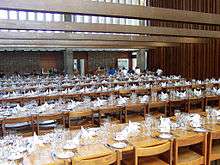
Churchill is a relatively young college, and prides itself on being modern and forward looking. It has relatively few traditions. Students are not required to wear gowns at formal halls,[24] with exception of certain college feasts.
In special formal meals such as Matriculation Dinner or Scholars' Feast the Master usually raises a toast, first to The Queen and then to "Sir Winston". In other formal halls this is usually made by a senior student once the fellows have left. This latter tradition started in the early 2000s with the students customarily toasting in the reverse order: "Sir Winston", followed by "The Queen".
People associated with the college
Masters
The Mastership of Churchill College is a Crown appointment. To date the College has had seven Masters:
- Sir John Cockcroft, (Master 1959–1967), Nobel Laureate in Physics, who split the atom.
- Sir William Hawthorne (Master 1968–1983), who helped develop the jet engine.
- Sir Hermann Bondi (Master 1983–1990), cosmologist who helped develop the Steady State theory of the universe.
- Sir Alec Broers (Master 1990–1996), nanotechnologist (left to become Vice-Chancellor, University of Cambridge).
- Sir John Boyd (Master 1996–2006), formerly British ambassador to Japan (1992–1996).
- Sir David Wallace (Master 2006[25]–2014), previously vice-chancellor of Loughborough University (1994–2005) and director of the Newton Institute (2006–2011).
- Dame Athene Donald (Master 2014[26]–present), professor of experimental physics at the Cavendish Laboratory.[27]
Notable fellows
See also Category:Fellows of Churchill College, Cambridge
- Michael Ashburner – Biologist, former head of the European Bioinformatics Institute and the European Molecular Biology Laboratory
- Correlli Barnett – Military historian
- Jacques Barzun – Historian and cultural critic; (Extraordinary Fellow at Churchill while also Provost, Dean of Graduate studies, and Dean of Faculties at Columbia.)
- Piers Brendon – Writer and historian
- Edward Bullard – Geophysicist, former head of the National Physical Laboratory
- Edward Craig – Philosopher
- George Gamow – Cosmologist (overseas fellow)
- Mark Goldie - Professor of Intellectual History
- Frank Hahn – Economist
- Archie Howie – Physicist
- Richard Keynes – Physiologist
- John Kinsella – Poet and novelist
- Nigel Knight - Economist and political scientist
- C. B. Macpherson – Political scientist
- Peter Murray-Rust – Chemist
- David Newbery – Economist
- Roy Porter – Historian and prolific author
- Stephen Roskill – Naval historian
- Andrew Sinclair – Historian, novelist and journalist
- C. P. Snow – Physicist and novelist
- George Steiner – Literary critic and linguistic theorist (Extraordinary Fellow at Churchill)
- Sir Colin St John Wilson – Architect
- Dick Tizard – Engineer
- Stuart Warren – organic chemist
- Chandra Wickramasinghe – Physicist and Astrobiologist
- Michael Young – Sociologist and politician
- Ghil'ad Zuckermann – Linguist and revivalist
Nobel laureates
- Philip Warren Anderson – Physics, for the behaviour of electrons in magnetic solids, 1977
- John Cockcroft – Physics, for using accelerated particles to study atomic nuclei, 1951
- Francis Crick – co-discoverer of the structure of DNA, Medicine, 1962
- Angus Deaton – Economics, 2015 (Overseas Fellow 1990–1): Analysis of consumption, poverty, and welfare
- Gérard Debreu – Economics, 1983
- Peter Diamond – Economics, 2010 (overseas fellow)
- Robert G. Edwards – Physiology or Medicine, 2010
- John Gurdon – Physiology or Medicine, 2012
- Antony Hewish – co-discoverer of pulsars, Physics, 1974
- William Lipscomb – Chemistry, 1976 (overseas fellow)[28]
- Mario Vargas Llosa – Literature, 2010 (overseas fellow)
- Eric Maskin – Economics, 2007 (overseas fellow)
- Wole Soyinka – Literature, 1986 (overseas fellow)
- David Thouless – Physics, 2016 (Fellow 1961–5): Theoretical discoveries of topological phase transitions and topological phases of matter.
- Roger Tsien – Chemistry, 2008
Notable alumni
See also Category:Alumni of Churchill College, Cambridge
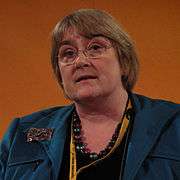

- Kari Blackburn – BBC World Service executive
- Baroness Brinton – Liberal Democrat peer
- Michael Burrows – Inventor of the first internet search machine, Alta Vista
- Peter Fincham – former controller, BBC1
- Sir Christopher Frayling – writer and educationalist
- Mike Gascoyne – Chief technical officer of the Caterham F1 Formula One team
- Sir Peter Gershon – author of the Gershon Review, chairman of Premier Farnell and Symbian Ltd.
- John Gladwin – Bishop of Chelmsford and Chair of Citizens Advice
- Michael Green – Lucasian Chair of Mathematics
- Roger Helmer – UK Independence Party MEP
- Diarmaid MacCulloch – Historian
- Viscount Monckton – Writer and policy advisor to Margaret Thatcher
- Simeon Nyachae – Kenyan minister and 2002 presidential candidate
- Brendan O'Neill – business executive
- David Pearson (computer scientist) - physicist and computer scientist
- Alix Pryde – BBC Controller of Distribution
- Luke Roberts – comedian
- Ian Stewart – Mathematician
- Gavin Strang – Labour MP
- Bjarne Stroustrup – inventor of C++
- Sir John Stuttard – Lord Mayor of London 2006/7
- Fabian Tassano – Economist and author
- Geoffrey Thomas – President of Kellogg College, Oxford
- Geoff Travis – Founder of Rough Trade Records label and shops
- Neil Turok – Mathematician
- Stephen Tweedie – Software developer
- Peter Wadhams - Oceanographer and glaciologist
- Rick Warden – Actor Band Of Brothers, Rome
- Jeremy Warmsley – musician
See also
- Churchill Scholarships for fourteen graduates from the United States.
- Churchill College Boat Club
References
- ↑ "Churchill College, Cambridge - Publication Scheme" (PDF). Retrieved 5 February 2010.
- ↑ "Dick Tizard, Obituary". The Independent. London. 10 October 2005. Retrieved 5 February 2010.
- ↑ "Churchill College Hospitality - About Churchill College". Retrieved 5 February 2010.
- ↑ Walsh, James Jackson (1998). "Postgraduate Technological Education in Britain: Events Leading to the Establishment of Churchill College, Cambridge, 1950-1958". Minerva. 36 (2): 147–177. doi:10.1023/A:1004396018945.
- ↑ "Churchill College Statutes (PDF)" (PDF). 1 January 2010. Retrieved 25 June 2012.
- ↑ "Churchill Archive Centre". Retrieved 25 June 2012.
- ↑ "The Møller Centre". Retrieved 25 June 2012.
- ↑ Goldie, M.; Corbusier Comes to Cambridge, Churchill (2007).
- ↑ "The Francis Crick Papers: Biographical Information". Retrieved 5 February 2010.
- ↑ "Churchill College: Information: Map of College". Retrieved 5 February 2010.
- ↑ McKie, Robin (17 September 2006). "Observer review: Francis Crick by Matt Ridley". The Guardian. London. Retrieved 5 February 2010.
- ↑ Highfield, Roger (20 March 2003). "Do our genes reveal the hand of God?". The Daily Telegraph. London. Retrieved 5 February 2010.
- ↑ "Dhruva Mistry". Retrieved 5 February 2010.
- ↑ . Geograph.org http://www.geograph.org.uk/photo/685470. Retrieved 13 September 2014. Missing or empty
|title=(help) - ↑ "Anthony Caro - Forum". Retrieved 5 February 2010.
- ↑ "Churchill MCR: What is an Advanced Student?". Retrieved 25 June 2012.
- ↑ "Churchill Casino". Retrieved 5 February 2010.
- ↑ "Churchill Casino donates to Cam-mind at Churchill College event on 20th March 2012". Cam-mind News. 22 March 2012. Retrieved 30 July 2012.
- ↑ "Churchill MCR: MCR Bar". Retrieved 25 June 2012.
- ↑ "Churchill MCR: Activities & Calendar". Retrieved 25 June 2012.
- ↑ "Churchill MCR: Conference on Everything". Retrieved 30 July 2012.
- ↑ "Pegasus Cup 2013 — The Milton Brewery, Cambridge Ltd". The Milton Brewery, Cambridge Ltd. Retrieved 13 September 2014.
- ↑ "Pegasus Cup - CUCBC". Retrieved 13 September 2014.
- ↑ "Churchill College MCR Frequently Asked Questions". Retrieved 12 December 2014.
- ↑ "Appointment of Master of Churchill College". Retrieved 5 February 2010.
- ↑ "Appointment of Next Master of Churchill College". Churchill College News. Retrieved 2 October 2013.
- ↑ Donald, A.; Jacobsen, S.D. (28 June 2013). "Dr. Athene Donald: Experimental Physicist, University of Cambridge". In-Sight (2.A): 85–97.
- ↑ "CV - Biog - Publications - Lipscomb". Retrieved 13 September 2014.
External links
| Wikimedia Commons has media related to Churchill College, Cambridge. |
Coordinates: 52°12′46″N 0°06′14″E / 52.212746°N 0.104020°E

